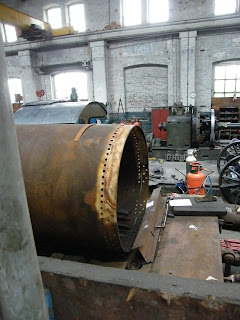More progress has taken place on the boiler with the forming of the last piece of new plate work.
Above is the basis of the new throatplate formed using the same method as the door plate shown previously.
Our latest collection of metal. Not a pile of scrap but the formers used to create the firebox platework. These are now available for any GWR loco owning group who require new platework for a std No 14 boiler.
We also understand that the doorplate is the same on a std No 10 boiler.
The last part of the jigsaw puzzle. This is the final former used in forming the throatplate. It is used to turn the lip back to meet the underside of the boiler barrel.
Here are the old and new throatplates sit side by side. The new plate in the former is ready for heating to form the flange to meet the boiler barrel. This flange can be seen standing up from the old throatplate in the foreground.
The view from underneath, here you can see where the plate needs heating and dressing down to meet the former, thus forming the flange for riveting to the boiler barrel.


















